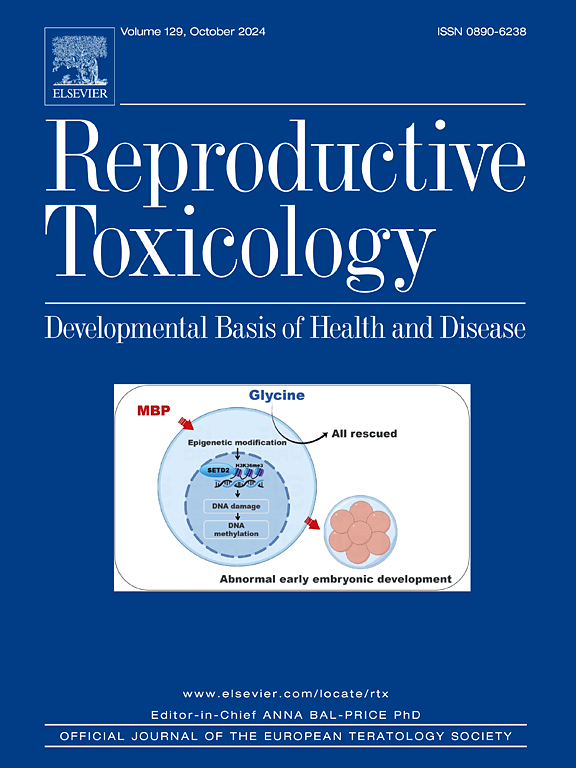Late histopathological impacts on the female prostate of gerbils exposed to BPA during pregnancy and lactation
IF 2.8
4区 医学
Q2 REPRODUCTIVE BIOLOGY
引用次数: 0
Abstract
The female prostate is regulated by steroid hormones, mainly androgens and estrogens. Exposure to exogenous chemical compounds leads to effects via endocrine pathways that alter prostate morphophysiology. Bisphenol A (BPA) is a widespread endocrine disruptor, which influences estrogenic pathways, facilitating pre-neoplastic and neoplastic alterations in hormone-sensitive organs. The aim of this study was to evaluate the influence of BPA on the prostate of aged female gerbils exposed to the compound during their gestational and lactational periods. The females were exposed to 50 μg/kg/daily during gestation and lactation, and the analysis was performed in the aged period (18-mo age). Our results showed that BPA increased epithelial alterations, observed by hyperplastic foci and a reduction in atrophies, commonly observed in aged female prostate. These data were supported by phopho-histone H3 immunostaining, that indicated proliferation of the epithelial and stromal compartments, leading to glandular hypertrophy. In addition, a pro-proliferative imbalance was observed through the differential expression of key proteins associated with cell death and proliferation, as well as in the expression of stromal components. Thus, the increase in cell proliferation implies the onset of epithelial alterations, as evidenced by the increased number of hyperplastic foci. The alterations reported after exposure to BPA demonstrated the increased likelihood of proliferative epithelial alterations, with tissue remodeling associated mainly with prostatic stroma.
妊娠和哺乳期暴露于双酚a的沙鼠雌性前列腺的后期组织病理学影响。
女性前列腺受类固醇激素,主要是雄激素和雌激素调节。暴露于外源性化合物导致影响通过内分泌途径,改变前列腺形态生理。双酚A (BPA)是一种广泛存在的内分泌干扰物,它影响雌激素通路,促进激素敏感器官的肿瘤前和肿瘤改变。本研究的目的是评估BPA对妊娠期和哺乳期暴露于该化合物的老年雌性沙鼠前列腺的影响。母鼠在妊娠期和哺乳期暴露于50μg/kg/d,在18月龄时进行分析。我们的研究结果表明,BPA增加了上皮的改变,表现为增生性病灶和萎缩的减少,这在老年女性前列腺中很常见。这些数据得到了磷酸组蛋白H3免疫染色的支持,显示上皮和间质室的增殖,导致腺体肥大。此外,通过与细胞死亡和增殖相关的关键蛋白的差异表达以及基质成分的表达,观察到促增殖失衡。因此,细胞增殖的增加意味着上皮改变的开始,增生灶数量的增加证明了这一点。暴露于双酚a后报告的改变表明增生性上皮改变的可能性增加,组织重塑主要与前列腺基质相关。
本文章由计算机程序翻译,如有差异,请以英文原文为准。
求助全文
约1分钟内获得全文
求助全文
来源期刊

Reproductive toxicology
生物-毒理学
CiteScore
6.50
自引率
3.00%
发文量
131
审稿时长
45 days
期刊介绍:
Drawing from a large number of disciplines, Reproductive Toxicology publishes timely, original research on the influence of chemical and physical agents on reproduction. Written by and for obstetricians, pediatricians, embryologists, teratologists, geneticists, toxicologists, andrologists, and others interested in detecting potential reproductive hazards, the journal is a forum for communication among researchers and practitioners. Articles focus on the application of in vitro, animal and clinical research to the practice of clinical medicine.
All aspects of reproduction are within the scope of Reproductive Toxicology, including the formation and maturation of male and female gametes, sexual function, the events surrounding the fusion of gametes and the development of the fertilized ovum, nourishment and transport of the conceptus within the genital tract, implantation, embryogenesis, intrauterine growth, placentation and placental function, parturition, lactation and neonatal survival. Adverse reproductive effects in males will be considered as significant as adverse effects occurring in females. To provide a balanced presentation of approaches, equal emphasis will be given to clinical and animal or in vitro work. Typical end points that will be studied by contributors include infertility, sexual dysfunction, spontaneous abortion, malformations, abnormal histogenesis, stillbirth, intrauterine growth retardation, prematurity, behavioral abnormalities, and perinatal mortality.
 求助内容:
求助内容: 应助结果提醒方式:
应助结果提醒方式:


